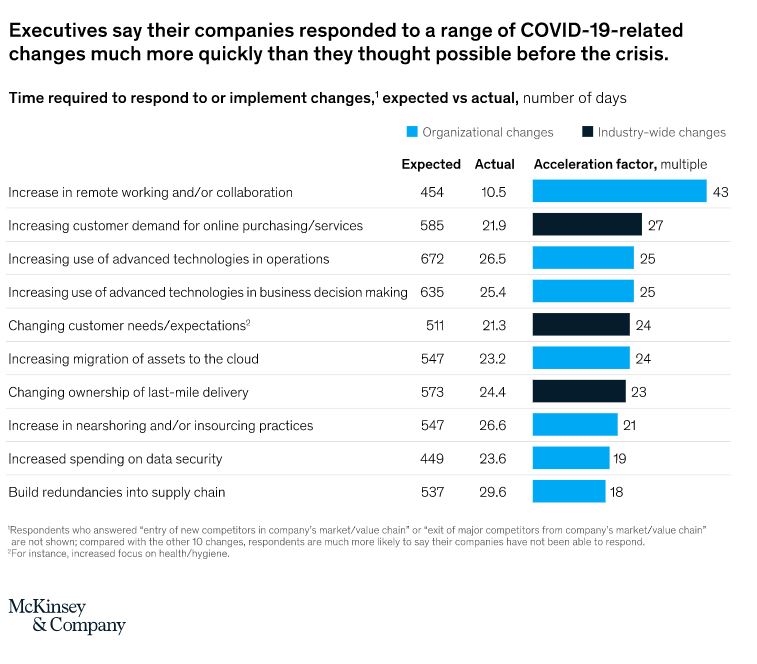Let’s be honest, 2020 didn’t live up to anyone’s predictions or expectations! That’s a rare statement that applies accurately to every person, brand, and country across the globe.
Ok, so the DAM industry probably did not live up to the ambitious 2020 predictions that analysts and vendors made in December 2019 and January 2020, well before most of us realised that a global pandemic would flip everything on it’s head. But all the more reason to review the predictions from last year. I’m curious to see if any of them still hold true for 2021 or if the world has changed so dramatically that technological and marketing trends have shifted in a new direction.
⚛️ 2020 Trend #1: Atomic Content Marketing, Dynamic Content, and Customer Experience
Brad Frost coined the term Atomic Design, and wrote the book on it, back in 2013. The original principle related to breaking down website and product design into smaller components or “atoms” and then building the design using these building blocks (like legos).
The concept was quickly applied to other areas of business and marketing. Atomic content is a similar model where “structured contents have been broken down into their smallest constituent parts, ready to be reused in larger contexts.”
Gartner for Marketers, Research Director, Chris Ross has gone as far as to say:
“Marketing leaders who master and implement atomic content concepts can improve customer experience and strengthen customer relationships.”
Gartner for Marketers, Research Director, Chris Ross
Production teams can now produce multiple assets from these atomic components held on a Digital Asset Management system. The DAM may hold the atomic components (such as images, voiceover audio, bits of copy, video clips, illustrations, animations, etc.) which can be used to create 50 variations of marketing collateral which can be used across all digital and print channels. Being able to collaborate on atomic content through the DAM has never been more important.
And to take this a step further, Dynamic Content, which is web or email content that changes based on personalisation preferences and behaviours, is driving more reliance on DAM systems and other integrated systems to deliver the correct content to the correct customer at the correct time.
Although Customer Experience (CX) has been top of mind for many marketing leaders for some time now, it has only recently impacted on the DAM industry. At the end of 2019, Forrester DAM expert, Nick Barber evaluated DAM suppliers on their ability to support the Customer Experience. And recently CXOToday recognised the benefits of DAM:
“Digital assets act like pillars that support the complete structure of customer experience. They engage the customer, help in developing a personalized touch, and make informed decisions.”
CXOToday
Tweet
Just at the end of 2020, we also saw DAM supplier, Widen, take a step to make the link with Customer Experience stronger by forming a partnership with digital experience platform Jahia.
I expect that personalisation and Customer Experience will further increase the need in 2021 for fully integrated martech stacks where the CRM, PIM, DAM, email marketing, CMS, and social media all play nicely in a connected ecosystem to deliver the optimal customer experience. Or some companies may choose to go the route of setting up Content Hubs as censhare predicted and Henry Stewart emphasized in 2020. Watch this space!
🛠️ 2020 Trend #2: The Rise of Print & Digital Brand Templating Tools
We’re not all awesome at graphic design. I sure wish I was as creative as many of the creatives I know, but alas, this is not how my brain works. Similarly, companies are struggling with balancing the cost and quality of creative content production. Sometime it’s worth hiring a talented graphic designer or creative agency to produce your campaign material. However, sometimes you just need a word or a price changed, a colour altered, or an image swapped out. We’ve finally arrived in this decade with no-code, no-graphic-design-experience-necessary tools that allow your average Joe to create beautiful, on-brand content quickly and inexpensively! Brands using print and digital templating tools have been able to save $1,000s and sometimes $millions.
This is another great achievement of 2019-2020 and will hopefully continue its traction long after. As we all know, marketing, communications, and press teams are hungry for content and no amount of content will feed the beast. Additionally, with the rise of “atomised content” and improved systems for digital personalisation, all brands need to be able to create more content, better content, and always on-brand content.
While some have opted for simple, social media templating tools such as Canva or Crello, many brands recognise the need to customise and control their branding using more specific tools such as Frontify, Chili Publish, and even some DAM companies (such as Bynder) are building capabilities in this area to ensure brand consistency in all content. Interestingly, many SaaS companies have a digital-first strategy which often means that print marketing goes overlooked. But print marketing is far from dead and companies still need comprehensive tools to create both print and digital marketing collateral within the same environment. Let’s hope we see improvements here in 2021.
🤖 2020 Trend #3: Better Utilization of Artificial Intelligence
Sure, sure, most DAM systems now have Artificial Intelligence elements as necessary to tick the box in the RFP exercise. But how useful is AI in DAM systems to end users? Many marketing teams believed AI would be the solution to all of their problems – no more metadata entry! no more search issues! and definitely no need for DAM Librarians! But alas, the robots have not conquered all and we still need complete and accurate metadata and DAM Librarians more than ever.
In 2020 we certainly did see DAM vendors using AI in smarter, more useful ways than ever before! For example, PhotoShelter leverage their new AI tool to recognize people, such as athletes, by combining facial recognition with jersey data. PhotoShelter AI can also be used to identify brand logos from sponsors and partners. And a much welcomed innovation in the DAM industry AI space is the ability to leverage 3 of the best image recognition engines (Google, Microsoft, and Amazon) as well as train the AI to recognise brand-specific attributes.
Cloudinary has also taken AI to the next level in 2020 by developing solutions to:

- Check images for accessibility for color-blind users
- Automatically crop images while centering the subject

In 2021, I expect that we will continue to see DAM vendors using AI beyond the expected image recognition capabilities. AI can be valuable in more innovative ways such as asset relationship and suggestion management, audio transcription and search (something that GrayMeta already do), and asset optimisation – smart focal point tracking, asset conversion and editing (such as removing backgrounds), etc.
Now if only AI could have warned us about the coronavirus approaching! (although there probably was an AI reporting tool somewhere madly spitting out warnings and trying to flag down a data scientist to report impending doom 🤖)
And now back to reality. Welcome to 2021! I expect in 2021, we will see more unexpected trends and surprising predictions as the world adapts to the “new normal” and the industry continues to innovate to meet the new challenges of this decade. Here are two surprising trends for 2021 which I would not have expected back in early 2020.
💻 Surprise Trend of 2021 #1: Remote working drives the purchase and adoption of web-based marketing collaboration tools
COVID-19 has caused much of the global workforce to work remotely and simultaneously moved the customer to digital-only interactions with brands.
Both digital staff members and digital customers have been a trigger for companies to either accelerate digital transformation or become obsolete.
Over 40% of businesses of all sizes have turned to web-based cloud software-as-a-service (SaaS) systems to reduce disruptions to their business operations and continue delivering delightful experiences to their customers…albeit in a very different format than many companies are accustomed to!
Companies with on-premise content technologies have struggled to keep up and have found themselves quickly replacing these older technologies with younger, more flexible SaaS tools. According to the McKinsey Global Survey, company executives have accelerated their digital transformation by 7 years by increasing the share of digital tools in their tech stacks. Not to mention, working remotely and under pressure, companies have increasingly prioritised the adoption of advanced SaaS technologies in their operations.

And despite budget freezes, I expect to see budgets thaw in 2021 as companies recognise the need to evolve or die. Forrester expects to see lifts in investment in marketing automation tools in 2021 as CMOs face the need to use technology to deliver efficiencies and optimizations that cannot be delivered by an already stretched workforce. Digital Asset Management is a prime candidate for companies to adopt, if they haven’t already, or move into the cloud with in 2021. And if you already have a DAM, 2021 is the year to optimize it to get the most value, efficiency, and ROI!
💰 Surprise Trend of 2021 #2: Inability to produce new content drives increased DAM ROI through content reuse
The pandemic has caused most brands to tighten the belt on creative production budgets, not to mention, for much of the pandemic, photographers, video production companies, and other creatives were not allowed to leave their homes or interact with their subjects. So what have companies done to carry on and even grow their digital marketing presence?
For many brands, the easy answer has been to look to their DAM systems for existing content and to reuse, repurpose, and upcycle this already paid-for content. Archives and museums were able to go online with their digital collections and even create interactive spaces. Even sports syndicates have used the gap in live sports to share footage of amazing games and matches from the past.
But when existing content won’t cut it, brands have relied more heavily on visuals from stock image and footage libraries or turned to graphic designs, illustrations, and animations which can be produced from the comfort of a creative’s home without exposing them to the pandemic raging in the outside world. Even content buying has now become easier, with tools like Smint.io leading the way. Companies who want to streamline reuse for 2021 and make the most of continually shrinking marketing budgets, will be wise to centralise valuable content into their “one-stop shop” DAM system, ensure that rights are properly contracted or licensed, and strategically communicate to ensure that staff are “buying once, re-using often”!
Don’t get left behind in 2021. If you need help to ensure that your creative and marketing operations are able to function efficiently and effectively in 2021 and beyond, let’s have a chat. You can contact me through LinkedIn or via email at kristinahuddart@gmail.com.
